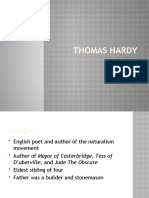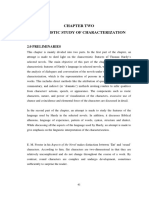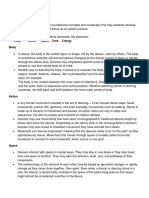DSDFSDF
DSDFSDF
Uploaded by
senaCopyright:
Available Formats
DSDFSDF
DSDFSDF
Uploaded by
senaCopyright
Available Formats
Share this document
Did you find this document useful?
Is this content inappropriate?
Copyright:
Available Formats
DSDFSDF
DSDFSDF
Uploaded by
senaCopyright:
Available Formats
Far from the MADDING crowd
Far from the Madding Crowd (1874) is Thomas Hardy's fourth published novel and his first major literary success. The novel is set in Thomas Hardy's Wessex in rural southwest
England and it deals in themes of love, honour and betrayal, against a backdrop of the seemingly idyllic, but often harsh, realities of a farming community in Victorian England. It
describes the life and relationships of Bathsheba Everdene with her lonely neighbour William Boldwood, the faithful shepherd Gabriel Oak, and the thriftless soldier Sergeant Troy.
DİLARA ALTUNTAŞ KÜBRA ASLAN SENA ÇELEBİ
THE ROLE OF NATURE IN «FAR FROM THE MADDING WOMEN’S POSITION IN VICTORIAN SOCIETY THROUGH HARDY’S USE OF SYMBOLS AND NARRATIVE
CROWD» THOMAS HARDY’S «FAR FROM THE MADDING CROWD» TECHNIQUE IN «FAR FROM THE MADDING CROWD»
In Far From the Madding Crowd (1874), Thomas Hardy In the Victorian Age, women’s lives were mainly The symbolism extends to objects such as timepieces,
portrays nature as an undeviating law that affects the restricted by strict social expectations that defined
which represent Gabriel and Troy's opposing values.
characters’ physical, social, and psychological their role around marriage, domesticity, and
Gabriel's unreliable silver watch indicates his
maturation process. The role of nature in the novel subservience to male authority. Women were expected
mirrors principles of Social Darwinism, where nature connection to the natural world and its cycles, whereas
to be morally pure, submissive, and sexually
controls and shapes the characters, guiding them oppressed, with their identities based on their roles as Troy's exquisite gold wristwatch, engraved "Cedit amor
toward their "perfect and tragic" versions in the rural wives and mothers. Education and job opportunities rebus" ("Love yields to circumstance"), shows his
society of Victorian England. The characters in the novel were limited, and any attempt at independence or separation from nature and reliance on material
engage with nature’s destructive powers, which work outside the home was often deemed sophistication. Similarly, character names have symbolic
symbolized by fire, storm, rain and other pastoral inappropriate or unfeminine. In contrast, Thomas meaning—Gabriel Oak connotes strength and
symbols such as sheep and harvest hay which play a Hardy’s *Far From the Madding Crowd* introduces an dependability, whereas Sergeant Troy's name invokes
crucial role to shape their maturation process, unusual and complex female protagonist, Bathsheba the pagan city of conquest and destruction, associating
individual fates, and emotional states. Hardy’s realistic Everdene, who challenges these societal norms. him with artificiality and chaos. Hardy's portrayals of
rural portrayal underscores the central as both a Bathsheba inherits her uncle’s farm and takes on the natural scenery highlight his characters' personalities.
nurturing and destructive force. Hardy does not portray role of managing it, defying the expectation that Bathsheba Everdene, typically associated with colorful,
romantic rural life but also depicts rural setting as women should be confined to domesticity. Her transient things such as flowers and birds, represents
battlefield with challenges that test the resilience and confidence and determination to run the farm, as she
beauty, grace, and volatility. Gabriel Oak, on the other
morality of his characters like Gabriel Oak’s loss of his says, “I shall be up before you are awake; I shall be
hand, is compared to stable and enduring elements such
sheep herd, the violent storm which threatens afield before you are up; and I shall have breakfasted
Bathsheba’s farm, marriage, anti-pastoral characters as the earth, sun, and Biblical figures, emphasizing his
before you are afield. In short, I shall astonish you all,”
like Troy and Boldwood by highlighting the encounter (Hardy, 70), highlights her determination and her aim position as the novel's moral center. Natural imagery is
between human struggles and the inevitable to challenge the stereotype that women are only also utilized to depict critical occasions. For example,
destructive forces of nature. suitable for domestic works, by demonstrating that Gabriel's action of protecting Bathsheba's ricks during a
Publication Date: 1874-1875 (serialized), 1874 (book)
At the beginning of the novel, Gabriel embodies pastoral she is capable of doing things equal to men. She storm emphasizes his role as a protector and a
values through his simplicity and connection to nature struggles with societal limitations on her identity, as character in harmony with nature. In contrast, Troy's Genre: Victorian, pastoral, social commentary
as a king shepherd. However, his life takes a tragic turn she reflects, “It is difficult for a woman to define her theatrical displays and Boldwood's stiff, death-like Setting: Wessex, rural England
when he loses his sheep, a tragedy that forces him to feelings in language which is chiefly made by men to imagery represent their distinct separations from nature Notable Characters: Bathsheba, Gabriel Oak, Sergeant Troy, William Boldwood
confront the harsh realities of life. Gabriel’s "matured express theirs” (Hardy, 290). Through her relationships and human connection. His preoccupation with physical
modesty and resilience“ highlights his growth, as he with three men—Gabriel Oak, Sergeant Troy, and Style: Realism, symbolism, psychological insight, vivid descriptions
details of landscape or character goes beyond the
changes from a proud shepherd to a more self-aware, William Boldwood—Bathsheba navigates the conventions of mid-Victorian realism. The famous "set- Narrative Perspective: Third-person omniscient
modest character for himself and Bathsheba. His complexities of love and marriage in a society that pieces" of the novels are neither word painting nor Love and Relationships: Complex dynamics of romantic, unrequited, and loyal love.
journey represents a moral growth driven by nature's views women as property. While Sergeant Troy’s merely "scene setting" but are organically and
challenges, contrasting with the tragic fates of other manipulative charm and Boldwood’s obsessive love Social Class: Influence of class on personal choices and social interactions.
intimately linked to the central issues of the novels,
characters, such as Troy and Boldwood. illustrate the harmful effects of Victorian masculinity, Fate vs. Free Will: Characters’ lives shaped by destiny and personal decisions.
Bathsheba, initially portrayed as a strong, independent often social, political, or moral. In Hardy's work,
her eventual marriage to Gabriel Oak represents a
woman, is drawn into a tragic marriage to Troy, which subversion of Victorian norms, built on mutual respect description is always charged with meaning, and Independence and Identity: Bathsheba’s struggle for autonomy in a patriarchal society.
ultimately undermines her autonomy. His failure to and equality. In contrast, Fanny Robin, a character description is substantially dependent upon perception. Originally considered the title The Rural Maid.
respect the natural world and his selfishness towards who represents working-class women, submits to Perception theory was a central issue in mid-Victorian
Marked a transition in Hardy’s writing, moving from poetry to novel writing.
Bathsheba’s needs leading to his tragic downfall. Victorian expectations, leading to a tragic end. psychology, and Hardy's novels, poetry, diaries,
Ultimately, the role of nature in Far From the Madding Bathsheba’s journey highlights her resistance to notebooks, and essays provide evidence of one who lived The novel features Hardy’s signature fictional Wessex region.
Crowd influences the maturation of characters like societal constraints, and through her experiences, in the eye, for whom "seeing" and "understanding" were First adapted to stage in 1876, soon after publication.
Gabriel and Bathsheba. Bathsheba accepts Gabriel’s Hardy critiques the patriarchal structures of Victorian more than simple metaphorical analogies. Hardy's
2015 film adaptation praised for strong performances, particularly Carey Mulligan as Bathsheba.
marriage proposal at the end of the novel symbolizes society. Ultimately, in *Far From the Madding Crowd*, predilection for symbolic narrative over direct criticism
her moral restored regeneration, as she returns to the Hardy uses Bathsheba’s experiences to make the is consistent with the impact of Romantic poets, who Tone: Romantic idealism mixed with tragic realism, exploring the consequences of love, choice, and fate.
true pastoral values represented by Gabriel. Through criticism of women’s position in Victorian society. used nature not only as a background but also as a Realism: Detailed portrayal of rural life and societal structures.
nature’s role and power, Hardy shows that the Through Bathsheba’s resistance and growth, Hardy medium to explore emotional and psychological
characters' fates are shaped by forces beyond their suggests a powerful commentary on the possibilities Symbolism: Nature mirrors emotional states and character development.
experiences. This method lends his characters and
control, and their ultimate growth comes from learning for women to challenge the restrictive gender roles Psychological Depth: Exploration of characters’ inner thoughts and motivations.
narratives a timeless, archetypal appeal that transcends
to accept and live in harmony with the natural world. and draw their own paths in a patriarchal society.!
the realities of his day. Fatalism: Underlying sense of inevitability in the face of human desires and actions.
You might also like
- Cute Sheep: Sheep Crochet Process Description by Guzel KhairutdinovaDocument14 pagesCute Sheep: Sheep Crochet Process Description by Guzel KhairutdinovaCreative Crochet100% (9)
- Hard Times-Questions and AnswersDocument8 pagesHard Times-Questions and AnswersFatma Musallam80% (5)
- Humour and IdentityDocument12 pagesHumour and IdentityLyann MartinezNo ratings yet
- How Far Do You Think Is The Title of The Novel Far From The Madding Crowd Justifiable?Document1 pageHow Far Do You Think Is The Title of The Novel Far From The Madding Crowd Justifiable?RAJIB DEBNATHNo ratings yet
- Thomas HardyDocument11 pagesThomas HardyImaan KhanNo ratings yet
- Thomas Hardy As A Great NovelistDocument7 pagesThomas Hardy As A Great NovelistRaees Ali Khan100% (1)
- Analysis of Thomas HardyDocument18 pagesAnalysis of Thomas HardyDhivyaNo ratings yet
- ENG 403 FinalDocument7 pagesENG 403 FinalWaseem ShahzadNo ratings yet
- 14 Wilde, O. - The Picture of Dorian GreyDocument6 pages14 Wilde, O. - The Picture of Dorian GreyhnnnnNo ratings yet
- BEGC-133-1ST (1)Document3 pagesBEGC-133-1ST (1)bs5509726No ratings yet
- 106 pages shymbolismDocument106 pages106 pages shymbolismsenaNo ratings yet
- Jeanée P. Sacken, "George Sand, Kate Chopin, Margaret Atwood, and The Redefinition of Self"Document6 pagesJeanée P. Sacken, "George Sand, Kate Chopin, Margaret Atwood, and The Redefinition of Self"PACNo ratings yet
- Thomas Hardy As A NovelistDocument3 pagesThomas Hardy As A NovelistshehbazNo ratings yet
- Far from the Madding Crowd by Thomas Hardy (Book Analysis): Detailed Summary, Analysis and Reading GuideFrom EverandFar from the Madding Crowd by Thomas Hardy (Book Analysis): Detailed Summary, Analysis and Reading GuideNo ratings yet
- An Ideal Husband EssayDocument4 pagesAn Ideal Husband EssayJosh Powell0% (1)
- Warner BlondebeastDocument4 pagesWarner Blondebeasteraserhead7No ratings yet
- Representation of Women in Virginia Woolf NovelDocument10 pagesRepresentation of Women in Virginia Woolf Novelaijazahmed1w1No ratings yet
- Consider Thomas Hardy's Far From The Madding Crowd As A Pastoral NovelDocument2 pagesConsider Thomas Hardy's Far From The Madding Crowd As A Pastoral NovelRAJIB DEBNATHNo ratings yet
- Orbiting The Center and Moving From It: Amy Dorrit and Harriet (Tattycoram)Document5 pagesOrbiting The Center and Moving From It: Amy Dorrit and Harriet (Tattycoram)Hristo BoevNo ratings yet
- Author Short Story - Realism and ReactionDocument3 pagesAuthor Short Story - Realism and ReactionVictor RobledaNo ratings yet
- Draft - Cevey - Literature EssayDocument3 pagesDraft - Cevey - Literature EssayDelfina CeveyNo ratings yet
- Great Books Final LessonsDocument8 pagesGreat Books Final LessonsKate PajeNo ratings yet
- Mrs RamsayDocument2 pagesMrs RamsayP TejeswaniNo ratings yet
- 2.14.5.20 Publications Bookmarks Original Bookmark Series Three Tragic Novels of Thomas Hardy Alma EversDocument7 pages2.14.5.20 Publications Bookmarks Original Bookmark Series Three Tragic Novels of Thomas Hardy Alma EversHarman KaurNo ratings yet
- Archetypes Stereotypes and The Female HeroDocument6 pagesArchetypes Stereotypes and The Female HeroThach VoNo ratings yet
- Hardy As A Pessimist NovelistDocument3 pagesHardy As A Pessimist NovelistKainat Maheen75% (4)
- Thomas Hardy As Pessimist Writer: Ack Skin, White Masks"Document15 pagesThomas Hardy As Pessimist Writer: Ack Skin, White Masks"Azhar KhanNo ratings yet
- Feministic Approach in The Tess of The D'urbervillesDocument7 pagesFeministic Approach in The Tess of The D'urbervillesrajvardhansinghchandel381No ratings yet
- CanadianDocument7 pagesCanadianThahera SirinNo ratings yet
- Book Review - What The Body RemembersDocument3 pagesBook Review - What The Body Rememberstejaswita kaushalNo ratings yet
- POEMS Frost, Robert The Death of The Hired Man (1914) Analysis by 2 CriticsDocument2 pagesPOEMS Frost, Robert The Death of The Hired Man (1914) Analysis by 2 CriticsMuhammad SaadNo ratings yet
- English Literature Presentation - To Dah Duh in Memoriam - Group 2Document15 pagesEnglish Literature Presentation - To Dah Duh in Memoriam - Group 2meltenolopez039No ratings yet
- Thesis Thomas HardyDocument8 pagesThesis Thomas Hardyvsiqooxff100% (1)
- Literary Analysis Sample - FinalsDocument3 pagesLiterary Analysis Sample - FinalsDeniseNo ratings yet
- Rustic Characters PDFDocument39 pagesRustic Characters PDFShahnawaz HussainNo ratings yet
- 5.themes: The Picture of Dorian GrayDocument7 pages5.themes: The Picture of Dorian Grayaidanmarais23No ratings yet
- Art of Characterization in A Tale of Two CitiesDocument2 pagesArt of Characterization in A Tale of Two Citiesmaria munir100% (1)
- Role of Fate and Chance in The Mayor of Casterbridge (B.A. Part11 Eng Hons Paper 1V 2019-20)Document3 pagesRole of Fate and Chance in The Mayor of Casterbridge (B.A. Part11 Eng Hons Paper 1V 2019-20)Tania TanveerNo ratings yet
- Assignment No 1Document10 pagesAssignment No 1Aiba AyatNo ratings yet
- Suggested Questions and Themes ComparasionDocument11 pagesSuggested Questions and Themes Comparasiona313kiNo ratings yet
- HF CharactersDocument5 pagesHF CharactersAudri DebnathNo ratings yet
- InceoglupaperDocument7 pagesInceoglupapermcbenignoNo ratings yet
- The Role of Slaves in HomerDocument6 pagesThe Role of Slaves in HomerSalome KatilyaNo ratings yet
- Hardy As A NovelistDocument2 pagesHardy As A NovelistSambad BasuNo ratings yet
- Female Subservience in Disney S Beauty and The BeastDocument9 pagesFemale Subservience in Disney S Beauty and The BeastXavier Martinez BartraNo ratings yet
- Sir William BradshawDocument4 pagesSir William BradshawKingshuk MondalNo ratings yet
- To DaDocument4 pagesTo DaChristine Hanoman SinghNo ratings yet
- The Duchess of Malfi Critics QuotesDocument33 pagesThe Duchess of Malfi Critics QuoteseshasachaniaNo ratings yet
- Universidad de Sevilla: "The Way You Wear Your Hat": Performativity and Self-Invention in Jackie Kay'sDocument10 pagesUniversidad de Sevilla: "The Way You Wear Your Hat": Performativity and Self-Invention in Jackie Kay'sJuan Angel CiarloNo ratings yet
- Romantic Hero: Mr. Fitzwilliam Darcy: Rahman 1Document5 pagesRomantic Hero: Mr. Fitzwilliam Darcy: Rahman 1syed tanvir jisanNo ratings yet
- Httpsans Names.pitt.Eduansarticledownload168016793362#~Text=The20Hebrew20name2022Bathsheba2220means,Yee20627)Document19 pagesHttpsans Names.pitt.Eduansarticledownload168016793362#~Text=The20Hebrew20name2022Bathsheba2220means,Yee20627)felipedeassis17No ratings yet
- umi copyDocument5 pagesumi copyumiNo ratings yet
- Văn họcDocument4 pagesVăn họcKtrina MaiNo ratings yet
- Great Expectations Story AnaDocument2 pagesGreat Expectations Story AnaRed Beans and RiceNo ratings yet
- Romanelli 31janDocument7 pagesRomanelli 31janAurora RomanelliNo ratings yet
- The Return of The NativeDocument10 pagesThe Return of The Nativesafder aliNo ratings yet
- Thomas HardyDocument8 pagesThomas HardySoumya PrakashNo ratings yet
- 94 98 Virginia Woolf's To The Lighthouse A Critical AnalysisDocument5 pages94 98 Virginia Woolf's To The Lighthouse A Critical AnalysisLaiba NabiNo ratings yet
- HaseemaDocument8 pagesHaseemahurairaNo ratings yet
- Charlote Bronty - Janeeyre Thomas Hardy - Tess of The D'UbervillesDocument3 pagesCharlote Bronty - Janeeyre Thomas Hardy - Tess of The D'Ubervillesdragostil88No ratings yet
- The Literary Imagination and the Victorian Crisis of Faith The Example of Thomas HardyDocument16 pagesThe Literary Imagination and the Victorian Crisis of Faith The Example of Thomas HardysenaNo ratings yet
- ANGLES OF VISION AND QUESTIONS OF GENDER IN FAR FROM THE MADDINGDocument17 pagesANGLES OF VISION AND QUESTIONS OF GENDER IN FAR FROM THE MADDINGsenaNo ratings yet
- 106 pages shymbolismDocument106 pages106 pages shymbolismsenaNo ratings yet
- Eastman-TIMEPROPRIETYFAR-1978Document15 pagesEastman-TIMEPROPRIETYFAR-1978senaNo ratings yet
- Carpenter-MirrorSwordImagery-1964Document16 pagesCarpenter-MirrorSwordImagery-1964senaNo ratings yet
- Training - JobDocument19 pagesTraining - JobhomespacedezignsNo ratings yet
- Weave Structure and Image Pattern Exploration For Modern Double-Cloth Design Development by Deploying Digital TechnologyDocument10 pagesWeave Structure and Image Pattern Exploration For Modern Double-Cloth Design Development by Deploying Digital Technology闕立凱No ratings yet
- Concert RegistryDocument30 pagesConcert Registryapi-349769438No ratings yet
- The Last Romantic: by Roy Macgregor-HastieDocument9 pagesThe Last Romantic: by Roy Macgregor-HastieAndreeaNo ratings yet
- Neon StyleDocument7 pagesNeon StyleEvelyn Lisset Cerna HernandezNo ratings yet
- Str-194826-St Regis Brand Style GuidelinesDocument39 pagesStr-194826-St Regis Brand Style GuidelinesDaz ArunabhNo ratings yet
- Art MovementDocument8 pagesArt Movementrabia wahidNo ratings yet
- The Princess and The Frog (2009)Document5 pagesThe Princess and The Frog (2009)Thùy Dương Huỳnh LêNo ratings yet
- Lefonse Esping Catalog 2017Document58 pagesLefonse Esping Catalog 2017Luqman HakimNo ratings yet
- Project Plans: Tool Storage CenterDocument14 pagesProject Plans: Tool Storage CenterJayme LealNo ratings yet
- Describing Peoples Appearance Worksheet Templates Layouts - 141245Document10 pagesDescribing Peoples Appearance Worksheet Templates Layouts - 141245Mohamed OsamaNo ratings yet
- Baby ShookyDocument5 pagesBaby ShookyLola DeYeyoNo ratings yet
- Revit Training Doc. PVVDocument3 pagesRevit Training Doc. PVVpraveencivilvarma9397No ratings yet
- Pre-Intermediate Quick Check Test 3A: GrammarDocument2 pagesPre-Intermediate Quick Check Test 3A: Grammaraleko abramiani100% (2)
- Existential Protagonist in Naguib Mahfouz's Novel "The Beggar"Document6 pagesExistential Protagonist in Naguib Mahfouz's Novel "The Beggar"IJELS Research JournalNo ratings yet
- Crochet GrannyDocument6 pagesCrochet GrannyNothing MuchNo ratings yet
- Artist ResearchDocument7 pagesArtist Researchapi-240876812No ratings yet
- Rubco Brochure EDITED FINALDocument40 pagesRubco Brochure EDITED FINALsrikanth_krishnamu_3No ratings yet
- Modul 4 BHS Inggris KLS 3 KD 3.4 - 4.4Document12 pagesModul 4 BHS Inggris KLS 3 KD 3.4 - 4.4jianahNo ratings yet
- A 'Macedonian Bronze' Juglet From Zagora, Andros - Stavros A. PaspalasDocument13 pagesA 'Macedonian Bronze' Juglet From Zagora, Andros - Stavros A. PaspalasSonjce Marceva100% (1)
- Glass Series 2022 - Light MakersDocument114 pagesGlass Series 2022 - Light Makersm.apoorvaNo ratings yet
- Soal Latihan CongratulationsDocument3 pagesSoal Latihan CongratulationsElisabeth Febry LianNo ratings yet
- Lizette S. Terrado G12-35: B A S T EDocument5 pagesLizette S. Terrado G12-35: B A S T EDUCKLIFENo ratings yet
- Fighter - Swordmaster - GM BinderDocument2 pagesFighter - Swordmaster - GM BinderFlavio BrazNo ratings yet
- First Harp Book 00 P AreDocument48 pagesFirst Harp Book 00 P AreMy Tra NguyenNo ratings yet
- LP Music TextureDocument4 pagesLP Music TextureAkosiral De Guzman100% (1)
- Colores GC 2022Document1 pageColores GC 2022Sergio JiménezNo ratings yet
- Dragon Ball Super - The Supreme Evil EngDocument15 pagesDragon Ball Super - The Supreme Evil Engod1.edebiriNo ratings yet
- 1537711jfs342 XII PracticeDocument3 pages1537711jfs342 XII Practicekvhflih.uNo ratings yet





























































































